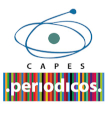Funções inorgânicas e digestão
uma proposta didática construída nas premissas da aprendizagem significativa e da aprendizagem cooperativa
DOI:
https://doi.org/10.22409/resa2020.v13i3.a29324Resumo
O processo de ensino-aprendizagem de Química no ensino médio tem se mostrado um desafio para professores e alunos. O uso de novas metodologias, assim como de materiais didáticos contextualizados com situações de vivência dos estudantes, revela-se uma alternativa ao modelo tradicional das aulas, auxiliando a transposição entre os conceitos químicos e o cotidiano dos alunos. O presente estudo objetiva averiguar se a utilização de uma Unidade de Ensino Potencialmente Significativa (UEPS), contextualizada com o tema relacionado à digestão, que foi organizada de maneira a atender às premissas da aprendizagem significativa (AS), concebida por David Ausubel, e da aprendizagem cooperativa (AC), desenvolvida pelos irmãos David Johnson e Roger Johnson, favorece a aprendizagem do conteúdo das funções inorgânicas de maneira mais significativa para os alunos. Para atender tal objetivo, o estudo caracteriza-se como qualitativo, utilizando para coleta dos dados questionários pré e pós-intervenção e a produção de cartazes pelos estudantes. A UEPS foi aplicada em uma turma com 25 alunos do primeiro ano do ensino médio de uma escola da rede estadual no município de Panambi, RS ao longo de 10 encontros. A análise dos dados coletados permitiu apontar para a viabilidade da proposta metodológica como indícios de uma AS, evidenciada pela ampla participação dos alunos durante as aulas, e resultados satisfatórios apontados nos questionários pré e pós-intervenção no trabalho cooperativo entre os alunos por meio da técnica Jigsaw para a confecção dos cartazes.
Downloads
Downloads
Publicado
Edição
Seção
Licença
Os autores que publicam nesta Revista concordam com os seguintes termos:
1. Autores mantém os direitos autorais e concedem à revista o direito da primeira publicação.
2. Autores têm autorização para assumir contratos adicionais separadamente, para distribuição não-exclusiva da versão do trabalho publicado nesta revista (ex.: publicar em repositório institucional ou como capítulo de livro), com reconhecimento de autoria e da publicação inicial nesta revista.






